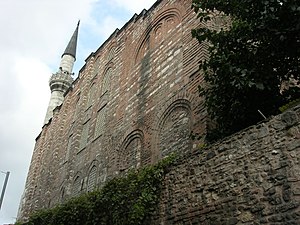Gül Mosque
| Gül Mosque Gül Câmîi |
|
|---|---|

Gül Mosque viewed from south, with the minaret in background, as of 2007[update]
|
|
| Basic information | |
| Location | Istanbul, Turkey |
| Geographic coordinates | 41°01′36.00″N 28°57′23.40″E / 41.0266667°N 28.9565000°E |
| Affiliation | Sunni Islam |
| Year consecrated | 1490, converted into a Mosque, late 900s, Church |
| Architectural description | |
| Architectural type | church with cross-in-square plan |
| Architectural style | Middle Byzantine - Comnenian |
| Specifications | |
| Length | 26 m |
| Width | 20 m |
| Minaret(s) | 1 |
| Materials | brick, stone |
Gül Mosque (Turkish: Gül Camii, meaning: "The Mosque of the Rose" in English) is a former Eastern Orthodox church in Istanbul, Turkey, converted into a mosque by the Ottomans.
The building is located in Istanbul, in the district of Fatih, in the neighborhood of Ayakapı ("Gate of the Saint"), along Vakıf Mektebi Sokak. It lies at the end of the valley which divides the fourth and the fifth hills of Constantinople, and from its imposing position it overlooks the Golden Horn.
It is one of the most important religious Byzantine buildings of Constantinople still extant, but its dedication and the date of its construction, which for long time appeared certain, are now disputed by scholars. It is either identified with the church belonging to the nunnery of Saint Theodosia (Greek: Μονή τής Άγιας Θεοδοσίας εν τοις Δεξιοκράτους, Monē tis Hagias Theodosias en tois Dexiokratous) or with that of the monastery of Christ the Benefactor (Greek: Μονή του Χριστού του Ευεργέτου, Monē tou Christou tou Euergetou).
The building, since Stephan Gerlach visited it in the late 15th century, has always been identified with the church of Hagia Theodosia en tois Dexiokratous. At the beginning of last century, Jules Pargoire identified the building as the church of Hagia Euphēmia en tō Petriō, built during the reign of Basil I (867–886), and brilliantly explained the change in its dedication. The German archaeologist Hartmut Schäfer, after studies performed in the 1960s on the dating of the basement, estimated the date of construction of the edifice between the end of the eleventh and the first half of 12th century, placing it in the Komnenian period, and identifying it hypothetically as the church of the monastery of Christos Euergetēs. He excludes the possibility that the Gül Mosque is the building where the body of Hagia Theodosia was brought after the end of the Iconoclasm period. On the other hand, he does not exclude the possibility that the building could have been dedicated to Hagia Theodosia in a later period.
...
Wikipedia
